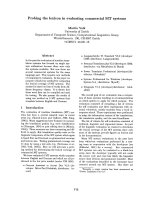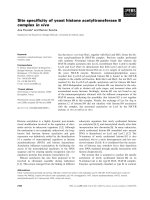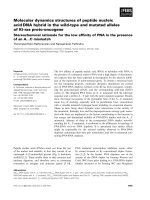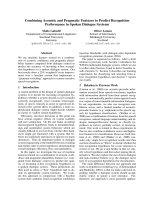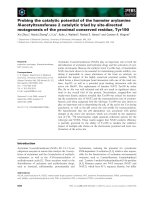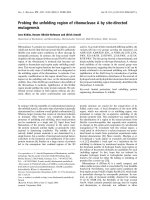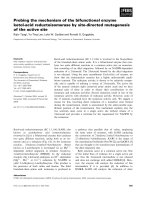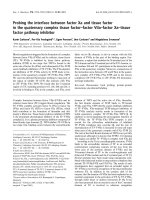Báo cáo khoa học: Probing the access of protons to the K pathway in the Paracoccus denitrificans cytochrome c oxidase pdf
Bạn đang xem bản rút gọn của tài liệu. Xem và tải ngay bản đầy đủ của tài liệu tại đây (209.87 KB, 9 trang )
Probing the access of protons to the K pathway in the
Paracoccus denitrificans cytochrome c oxidase
Oliver-M. H. Richter
1
, Katharina L. Du
¨
rr
1
, Aimo Kannt
2
, Bernd Ludwig
1
, Francesca M. Scandurra
3
,
Alessandro Giuffre
`
3
, Paolo Sarti
3
and Petra Hellwig
4
1 Institut fu
¨
r Biochemie, Abteilung Molekulare Genetik, Johann Wolfgang Goethe-Universita
¨
t, Frankfurt-am-Main, Germany
2 Max-Planck-Institut fu
¨
r Biophysik, Abteilung Molekulare Membranbiologie, Frankfurt-am-Main, Germany
3 Department of Biochemical Sciences and CNR Institute of Molecular Biology and Pathology, University of Rome ‘La Sapienza’, Rome,
Italy
4 Institut fu
¨
r Biophysik, Johann Wolfgang Goethe-Universita
¨
t, Frankfurt-am-Main, Germany
Cytochrome c oxidase of Paracoccus denitrificans [1–4]
resides in the cytoplasmic membrane of this soil bac-
terium and reduces molecular oxygen to water. In a
process still poorly understood, the free energy of the
redox reaction is exploited to translocate protons
across the membrane. Electrons donated by cyto-
chrome c are first transferred to a homobinuclear cop-
per center (Cu
A
) located in the periplasmic domain of
subunit II. Subsequently heme a and another binuclear
center consisting of heme a
3
and Cu
B
, all constituents
of subunit I, become reduced. Protons needed for
water formation and those to be translocated across
the membrane are taken up from the inner side by two
different pathways that were identified initially by site-
directed mutagenesis experiments [5–7] and were con-
firmed in the X-ray structures resolved so far [3,8–11].
A considerable line of evidence suggests that not only
those protons that are pumped across the membrane,
but also most of the protons required for the forma-
tion of water are delivered via the so called D channel
(named after a functionally critical aspartate residue at
its entrance, D124 in Paracoccus numbering) [12–14].
The separate K channel is indispensable for proton
transfer linked to the reduction of the binuclear site
and, consistently, mutations in this channel give rise to
a drastically retarded reduction of heme a
3
[12,15–17].
In contrast to the aspartate of the D channel, the cru-
cial lysine residue (K354 in Paracoccus) is located well
within the membrane dielectric [3]. Mutation of resi-
dues close to the K channel entrance do not elicit the
Keywords
cytochrome c oxidase; FTIR; proton channel;
electron transfer; site-directed mutagenesis
Correspondence
O M. H. Richter, Institut fu
¨
r Biochemie,
Abteilung Molekulare Genetik, Johann
Wolfgang Goethe-Universita
¨
t, Germany
Fax: +49 79 829244
Tel: +49 79 829240
E-mail:
(Received 23 August 2004, revised 1
November 2004, accepted 12 November
2004)
doi:10.1111/j.1742-4658.2004.04480.x
In recent studies on heme-copper oxidases a particular glutamate residue in
subunit II has been suggested to constitute the entry point of the so-called
K pathway. In contrast, mutations of this residue (E78
II
) in the Paracoccus
denitrificans cytochrome c oxidase do not affect its catalytic activity at all
(E78
II
Q) or reduce it to about 50% (E78
II
A); in the latter case, the mutation
causes no drastic decrease in heme a
3
reduction kinetics under anaerobic con-
ditions, when compared to typical K pathway mutants. Moreover, both
mutant enzymes retain full proton-pumping competence. While oxidized-
minus-reduced Fourier-transform infrared difference spectroscopy demon-
strates that E78
II
is indeed addressed by the redox state of the enzyme,
absence of variations in the spectral range characteristic for protonated
aspartic and glutamic acids at 1760 to 1710 cm
)1
excludes the protonation
of E78
II
in the course of the redox reaction in the studied pH range, although
shifts of vibrational modes at 1570 and 1400 cm
)1
reflect the reorganization
of its deprotonated side chain at pH values greater than 4.8. We therefore
conclude that protons do not enter the K channel via E78
II
in the Paracoccus
enzyme.
Abbreviations
SHE¢, standard hydrogen electrode (at pH 7); SVD, singular value decomposition; VIS, visible.
404 FEBS Journal 272 (2005) 404–412 ª 2004 FEBS
expected inhibition of the enzyme (for example S291 in
Paracoccus [7], see also [18]). A possible explanation
was given by electrostatic calculations indicating that
the redox state of the binuclear center influences the
protonation state of a glutamate residue positioned at
the cytoplasmic end of the second helix of subunit II
(E78 in Paracoccus) [19], subsequently considered a
potential K channel entrance residue (see below).
Experiments were first performed with mutants in
the corresponding position of the Escherichia coli bo
3
quinol oxidase (E89
II
Q ⁄ A ⁄ D) where a considerable
drop in oxidase activity was observed (to 10, 43 and
60%, respectively), and enzymes with the A or Q
mutation could not support aerobic growth of strains
devoid of other terminal oxidases on nonfermentable
substrates [20]. It is not clear on the other hand whe-
ther this inability to sustain growth reflects an
impaired proton pump or is a consequence of the
reduced enzymatic activity. In the E. coli bo
3
oxidase,
mutation of E89
II
to Q has been proposed to block the
reduction of the heme-copper binuclear center, lending
support to the idea that E89
II
is actually at the
entrance to the K channel or at least critically import-
ant for its functionality. An even broader range of
substitutions were introduced at the corresponding glu-
tamate (E101) into the cytochrome c oxidase of Rho-
dobacter sphaeroides [18,21]. There, oxidase activity is
reduced even more drastically in all mutant enzymes
(14, 8 and 16% residual activity for E101Q ⁄ A ⁄ D,
respectively), with the highest activity of about 30%
retained in E101H. In addition, a correlation was
observed between the diminished steady-state activity
and the slower rate of heme a
3
reduction under anaer-
obic conditions, discussed as an impairment of proton
delivery through the K channel. As mutations of E101
fulfill criteria that have also been observed with bona
fide K channel mutants (for example K362 in Rhodo-
bacter), E101 has been considered to be the dominant
entry point for protons going into the K channel [21].
Electrochemically induced FTIR difference spectros-
copy is a tool to study the reorganization of a protein
upon electron transfer and concomitant proton trans-
fer. The spectra reveal the contributions of residues
addressed by the redox reaction and are specific for
their protonation state. For the cytochrome c oxidase
from P. denitrificans the protonation state of E278
[22], of individual heme propionates [23,24] and of
Y280 [25] was previously studied employing this tech-
nique in combination with site-directed mutants and
isotopic labeling.
Here mutants of E78
II
in the Paracoccus cyto-
chrome c oxidase are characterized in terms of cata-
lytic and proton pumping activity, kinetics of heme a
3
reduction and electrochemically induced FTIR differ-
ence spectroscopy. Based on the modest effects caused
by the mutations, it is concluded that in the Paracoc-
cus oxidase E78
II
does not play the critical
role documented in the case of the E. coli and the
R. sphaero-ides oxidases.
Results
Enzymatic turnover and electron transfer
Mutations of position E78 in subunit II of the Para-
coccus cytochrome c oxidase were introduced to probe
the relevance of this residue for the catalytic properties
of this enzyme in general, and to monitor spectros-
copic changes that result from the substitution of this
residue to either glutamine or alanine.
Mutant oxidases were purified and characterized by
VIS redox spectroscopy and SDS gel electrophoresis.
Essentially no differences were observed in compar-
ison with wild-type oxidase with respect to heme and
subunit composition (not shown). The cytochrome c
oxidase activity of E78
II
Q matched that of wild-type,
while the activity of the E78
II
A mutant was lowered
to about 50% (Table 1).
Given the lower activity of the E78
II
A mutant, the
kinetics of reduction of this mutant were investigated
by stopped-flow spectrophotometry by anaerobically
mixing a degassed sample of the mutant in the oxidized
state with a large excess of ascorbate and ruthenium
hexamine (20 and 1 mm after mixing, respectively).
Within a few milliseconds after mixing a fast reduction
of heme a occurs (data not shown), similarly to what
was reported for the wild-type enzyme and the K354M
mutant under identical experimental conditions [26].
On a longer time scale (from 20 ms to 20 s), heme a
3
becomes reduced and the corresponding typical absorp-
tion changes are consistently observed (Fig. 1, top
panel).
Table 1. Enzymatic activity and proton-pumping capacity of wild-
type and mutant oxidases isolated from Paracoccus denitrificans.
Reconstituted oxidases were measured either with a stopped-flow
apparatus or potentiometrically (for details see Experimental proce-
dures). Enzymatic activity has been determined with samples from
the same oxidase preparations. 100% activity corresponds to a turn
over of 325 electrons s
)1
.
Oxidase-type
Enzymatic
activity (%) H
+
⁄ e
–
WT 100 1.04
a
⁄ 1.0
b
E78
II
A 50 1.10
a
E78
II
Q921.0
b
a
Stopped-flow apparatus;
b
potentiometric method.
O M. H. Richter et al. Proton access to Paracoccus cytochrome c oxidase
FEBS Journal 272 (2005) 404–412 ª 2004 FEBS 405
The time course of heme a
3
reduction in the E78
II
A
mutant as obtained by global fitting analysis of the
observed absorption changes is depicted in Fig. 1 (bot-
tom panel). By comparison with the wild-type enzyme,
it is evident that, unlike the K354M mutation, the
E78
II
A mutation only slightly affects the rate of
heme a
3
reduction. The observed kinetic effect is
remarkably smaller than the one reported for the same
mutation at the corresponding residue in the R. sph-
aeroides oxidase [21]. In all Paracoccus samples heme
a
3
reduction is biphasic, similarly to what was previ-
ously observed with the beef heart enzyme [27]. The
existence of two kinetic phases associated to identical
absorption changes demands further investigation,
although it can be tentatively assigned to two enzyme
subpopulations with different kinetic properties. In the
case of the Paracoccus wild-type enzyme, the observed
fitted rate constant relative to the major kinetic phase
( 19 s
)1
corresponding to 70% of the reaction
amplitude) is about four-fold lower than the turnover
number for O
2
consumption ( 80 mol O
2
Æmol
6
enzy-
me
)1
Æs
)1
). As previously shown for the Paracoccus
enzyme [26], this is expected given the unfavorable
redox equilibrium between heme a and heme a
3
,ifitis
taken into account that our measurements were carried
out in the absence of NO acting as a trapping ligand
for reduced heme a
3
[27].
Proton-pumping activity
To complement these results on electron transfer
with proton-pumping measurements, purified mutant
oxidases were reconstituted into phospholipid vesicles
by the cholate dialysis method (see Experimental pro-
cedures). Both the E78
II
Q and the E78
II
A mutant
oxidases show unimpaired proton-pumping (Table 1).
The H
+
⁄ e
–
ratio for E78
II
Q was found to be around
1.0 when determined by the reductant pulse potentio-
metric method [28]. The E78
II
A mutant was tested in a
stopped-flow approach monitoring the absorbance
change of the pH-sensitive dye phenol red [29]. Experi-
ments in the absence and presence of the uncoupler
CCCP gave a H
+
⁄ e
–
ratio of 0.9 very similar to that
of the wild-type enzyme (Fig. 2). Due to slight varia-
tions during oxidase reconstitution, proteoliposomes
with incorporated E78
II
A oxidase result in a faster
proton ejection than those with reconstituted wild-
type, although activity measurements clearly show a
diminished activity for this mutant (Table 1).
Electrochemically induced FTIR difference
spectroscopy
As the above experiments do not provide any informa-
tion about structural details of the E78
II
A and E78
II
Q
mutant enzymes, electrochemically induced FTIR
difference spectra of the corresponding cytochrome c
oxidases were recorded to detect molecular changes
concomitant with the redox reaction. This approach
allows monitoring of conformational changes or
Fig. 1. Kinetics of heme a
3
reduction of wild-type and mutant
P. denitrificans oxidase. Degassed samples of the oxidized enzyme
(wild-type, E78
II
A and K354M) were anaerobically mixed with ascor-
bate and ruthenium hexamine (20 and 1 m
M after mixing, respect-
ively) at 20 °C. Under these conditions the reduction of heme a is
complete within a few milliseconds, followed by the reduction of
heme a
3.
(Top panel) Absorption changes collected from 20 ms to
20 s after mixing the E78
II
A with the reductants (baseline: endpoint
spectrum acquired at 20 s). Within the experimental error singular
value decomposition (SVD) analysis of this spectra set yields only
one significant U-column, corresponding to the ox-red spectrum of
heme a
3
(inset). (Bottom panel) Time courses of heme a
3
reduction
as obtained by SVD analysis. Fitted rate constants with relative
amplitudes in brackets: wild-type enzyme, k
1
¼ 18.7 s
)1
(70%),
k
2
¼ 1.1 s
)1
(30%); E78
II
A mutant, k
1
¼ 14.5 s
)1
(35%), k
2
¼
0.38 s
)1
(65%); K354M mutant, k
1
¼ 0.09 s
)1
(30%), k
2
¼
0.005 s
)1
(70%). Data on the K354M mutant are from [34].
Proton access to Paracoccus cytochrome c oxidase O M. H. Richter et al.
406 FEBS Journal 272 (2005) 404–412 ª 2004 FEBS
charge redistributions at the cofactor sites, reflecting
the reorganization of the hemes, of the polypeptide
backbone and of the amino acid side chains upon
electron transfer to ⁄ from the redox active centers
(hemes a ⁄ a
3
,Cu
B
or Cu
A
). Additionally proton reac-
tions concomitant with electron transfer are expected
to contribute to the spectra. The electrochemically
induced FTIR difference spectra of wild-type cyto-
chrome c oxidase were previously published and dis-
cussed in detail [30,31].
Figure 3 shows the oxidized-minus-reduced FTIR
difference spectra of the E78
II
Q (A) and E78
II
A (B)
mutant enzymes (full line) in direct comparison to
wild-type (dotted line) for a potential step from )0.29
to 0.71 V at pH 7. A clear decrease of the negative
mode concomitant with the reduced form at 1546 cm
)1
can be seen for both mutants in direct comparison to
wild-type. Small shifts are present at 1720, 1676, 1638,
1619, 1554 and 1390 cm
)1
. No major variations, how-
ever, are present, demonstrating that the overall struc-
ture of the proteins is not affected upon mutation. In
order to distinguish the shifts, double difference spec-
tra have been obtained via subtraction of the differ-
ence spectra for the mutant enzymes from wild-type
(C). The glutamine of E78
II
Q may contribute upon
electron transfer: contributions of the m(C¼O) vibra-
tional mode of glutamines can be expected at 1668 to
1687 cm
)1
and of the d(NH
2
) at 1585 to 1611 cm
)1
Fig. 3. FTIR difference spectroscopy of E78
II
Q and E78
II
A variants.
Oxidized-minus-reduced FTIR difference spectra of the E78
II
Q(A)
and E78
II
A (B) mutant enzymes (line), each in comparison to wild-
type (dotted line) for a potential step from )0.29 to 0.71 V at pH 7.
The double difference spectra were obtained via subtraction of the
difference spectra for the E78
II
Q (C, line) and E78
II
A (C, dotted line)
mutant enzymes from wild-type (C). For experimental details see
Experimental procedures.
Fig. 2. Proton translocation of reconstituted E78
II
A (A) and wild-
type (B) Paracoccus oxidase. Reconstituted enzyme was mixed aero-
bically in the presence and absence of the uncoupler CCCP,
using the indicator dye phenol red to monitor pH changes in the
cuvette. Negative excursion denotes an acidification of the exter-
nal medium. For details see Experimental procedures.
O M. H. Richter et al. Proton access to Paracoccus cytochrome c oxidase
FEBS Journal 272 (2005) 404–412 ª 2004 FEBS 407
[32]. The increase of a difference signal at 1676 and at
1608 cm
)1
, however, is also observed for the E78
II
A
mutant and rather seems to reflect a small structural
variation induced by each amino acid substitution (see
below).
The decrease of the negative mode at 1546 cm
)1
and
of the positive mode at 1554 cm
)1
that can be seen
comparing the difference spectra for mutant and wild-
type enzyme, occurs in the spectral region where the
m(COO
–
)
as
from deprotonated glutamic acids are
expected. The corresponding m(COO
–
)
s
modes are usu-
ally significantly smaller and may be involved in the
variations around 1390 cm
)1
. The changes of these dif-
ferential signals upon mutation indicate that E78
II
is
deprotonated at the given pH conditions (phosphate
buffer, pH 7) and reorganizes upon redox reaction. We
note that these modes are present in a complex spec-
tral range, where also the amide II mode of secondary
structure elements contribute. An effect on the m(C¼C)
vibrations of the hemes, which are also included in
that spectral region, however, seems unlikely on the
basis of the distance of the mutation from the heme
porphyrin rings.
Protonated acidic residues characteristically contri-
bute above 1710 cm
)1
. Only a very small and broad
variation is seen at 1720 cm
)1
, which would be typ-
ical for a residue at the surface due to conformation-
al flexibility of the carboxylic side chain. The
intensity of this variation is significantly smaller than
what would be expected for a protonation reaction.
To assess whether this variation reflects partial pro-
tonation of the E78
II
side chain at pH 7, electro-
chemically induced FTIR difference spectra were
obtained for the E78
II
Q mutant enzyme, equilibrated
at pH 4.8 in cacodylate buffer.
Figure 4 shows the electrochemically induced FTIR
difference spectra at pH 7 (solid line) and 4.8 (dotted
line) of wild-type (A) and compares it to the E78
II
Q
mutant enzyme equilibrated at the same pH values (B)
as well as the direct comparison of wild-type (dotted
line) with the E78
II
Q mutant (solid line) at pH 4.8 (C).
Interestingly a broad positive mode at 1718 cm
)1
and
strong negative modes at 1556 and 1402 cm
)1
show
the largest deviation between each pair of spectra, for
both wild-type and mutant. The signal at 1718 cm
)1
most likely arises from m(C¼O) modes of the protonat-
ed form of carboxylic groups and the modes at 1556
and 1402 cm
)1
from the m(COO
–
)
s ⁄ as
vibrational
modes of the corresponding deprotonated form. The
relation of the extinction coefficients of these modes
are close to model compound studies on proto-
nation ⁄ deprotonation of isolated acidic amino acids in
solution [32]. We attribute these modes to the proto-
nation of carboxylic groups upon oxidation at pH 4.8,
the group being deprotonated above pH 5. The band
width of the contribution at 1718 cm
)1
indicates that
residues close to the surface, or in the vicinity of sev-
eral water molecules are involved here. Comparing the
spectra of the E78
II
Q mutant and wild-type for both
pH values (Fig. 4), no additional pH-dependent varia-
tions can be seen, which are not present in the wild-
type spectra as well, excluding E78
II
to be this residue.
This conclusion is supported by the clear decrease at
1546 cm
)1
that is not changed for the low pH value
(Fig. 4C). Our experimental data show that the pK
A
Fig. 4. pH dependence of the infrared signals for the E78
II
Q vari-
ant. Oxidized-minus-reduced FTIR difference spectra at pH 7 (full
line) and 4.8 (dotted line) of wild-type (A) and E78
II
Q (B) cyto-
chrome c oxidase for a potential step from )0.29 to 0.71 V as well
as the direct comparison between wild-type (dotted line) and
E78
II
Q mutant at pH 4.8 (C).
Proton access to Paracoccus cytochrome c oxidase O M. H. Richter et al.
408 FEBS Journal 272 (2005) 404–412 ª 2004 FEBS
value of E78 is thus below 5 and a protonation of the
residue is not expected at pH values above 5.
Discussion
Electrostatic calculations identified a glutamate (E78)
as a redox-responsive residue in subunit II of the
P. denitrificans cytochrome c oxidase [19]. It is located
at the cytoplasmic side of helix II at a distance of 9 A
˚
to the lysine of the K channel (K354) [3]. Subsequently
this residue gained considerable attention due to a
potential importance for access of protons into the
K channel of heme-copper oxidases.
Glutamate residues in equivalent positions of other
oxidases (E89 in the E. coli bo
3
ubiquinol oxidase [20]
and E101 in the R. sphaeroides aa
3
cytochrome c oxid-
ase [21], were mutated, amongst others, to A and Q,
revealing clear defects in their catalytic properties. The
activity in the A and Q mutants was diminished con-
siderably, namely to 43 and 10% (E. coli bo
3
) and to
8 and 14% (R. sphaeroides aa
3
), respectively. Both
E. coli mutants failed to complement aerobic growth
on nonfermentable substrates (in the absence of other
oxidases) which unfortunately cannot be correlated
directly with an impaired proton pump without addi-
tional information. No corresponding information is
available for the Rhodobacter mutants. The observed
mutational effects were assigned to a lowered rate of
reduction of the binuclear center caused by an
impaired proton transfer through the K channel.
Our results obtained with the corresponding muta-
tions in the P. denitrificans cytochrome c oxidase
clearly contradict those summarized above. Although
we observe a modest reduction of the catalytic activity
in E78
II
A to about 50% of the wild-type level, the
E78
II
Q mutation shows unchanged catalytic compet-
ence. More importantly, proton-pumping is essentially
unaffected in both mutant enzymes. It therefore seems
that E78
II
lacks a direct role in the overall enzymatic
reaction of the Paracoccus enzyme in contrast even to
the closely related R. sphaeroides aa
3
oxidase [21].
Interestingly, mutation of E78
II
to A causes only a
slight effect on the kinetics of heme a
3
reduction, much
smaller than that caused by mutation of other residues
widely accepted as belonging to the K channel, like
K354 [26]. Our measurements were carried out under
anaerobic conditions at high reductant concentration,
i.e. under conditions in which the very fast reduction
of heme a does not limit the overall reduction rate of
the enzyme [26,27]. Given that a drastically lowered
rate of heme a
3
reduction is considered as diagnostic
for mutated residues in the K channel, we conclude
that in the P. denitrificans aa
3
cytochrome c oxidase
E78
II
does not represent the dominant entry point for
protons into the K-channel. We used redox-induced
FTIR difference spectroscopy to monitor whether
E78
II
is addressed by the redox reaction at all. At
given pH conditions, signals characteristic for a
deprotonated carboxylic group were identified. Both
mutants lead to similar changes of nearby residues
revealing small structural variations induced in the
enzyme. Based on their full proton-pumping activity
and the moderate effect on enzymatic turnover activit-
ies, as well as the reduction kinetics for E78
II
A, we
conclude that this reorganization of E78 carboxylate
upon the redox reaction is, however, without direct
implications on the catalytic cycle in the cytochrome c
oxidase from P. denitrificans.
It is difficult to reconcile the discrepancy observed
with mutations of the particular glutamate residue,
especially between the closely related aa
3
cytochrome c
oxidases of Paracoccus and Rhodobacter. S291 as an
alternative for the entrance to the K channel of the
Paracoccus oxidase as deduced from the X-ray struc-
ture [3], has been addressed by mutation before [33],
however, without effect on the overall enzymatic reac-
tion.
It therefore seems that funneling of protons into the
K channel is just one of several examples of differences
between even closely related terminal oxidases that
operate on a common mechanistic ground but allow
for a certain degree of flexibility in the design of indi-
vidual mechanistic steps.
Experimental procedures
Mutagenesis and cloning
Site-directed mutations of subunit II were introduced with
the Altered Sites
Ò
system employing pAlter-1 (Promega),
and subsequently confirmed by sequencing. The mutated
subunit II gene together with the rest of the cta operon [34]
was cloned as a XhoI ⁄ HindIII fragment into appropriately
cut pUP39 [33] that allows for replication in Paracoccus
strain ST4 [35] where most of the cta operon from ctaCto
ctaE had been replaced by a kanamycin resistance gene.
Cell growth and protein purification
Growth of the Paracoccus strains and purification of the
oxidases with a tagged F
v
antibody fragment was per-
formed as described [33,36]. For electrochemistry the pro-
tein samples were further concentrated to 0.5 mm aa
3
using Microcon ultrafiltration cells (Millipore) and 200 mm
phosphate (pH 7), or 200 mm cacodylate buffer (pH 4.8),
both containing 100 mm KCl and 0.05% n dodecyl-b-
O M. H. Richter et al. Proton access to Paracoccus cytochrome c oxidase
FEBS Journal 272 (2005) 404–412 ª 2004 FEBS 409
d-maltopyranoside. For proton-pumping experiments the
oxidases were bound to 2 mL columns of Q-sepharose
(Amersham), washed with 10 mm Hepes pH 7.3, 50 mm
KCl, 0.015% dodecylmaltoside and eluted with 500 mm
KCl in the same buffer.
Cytochrome c oxidase activity
Enzymatic activity was determined at room temperature
with 20 lm reduced horse heart cytochrome c (Sigma) at
550 nm with a Hitachi U-3000 spectrophotometer. The
reaction buffer contained 20 mm Tris ⁄ HCl pH 7.5, 20 mm
KCl, 1 mm EDTA and 0.02% dodecylmaltoside.
Electron transfer measurements
The kinetics of reduction of the enzyme were investigated
at 20 °C by using a stopped-flow apparatus (DX.17MV,
Applied Photophysics, Leatherhead, UK), equipped with a
photodiode-array (light path ¼ 1 cm). Absorption spectra
were collected with an acquisition time of 2.56 ms up to
20 s after mixing. Buffer: 20 mm phosphate pH 7.0, 50 mm
NaCl, 0.1% dodecylmaltoside. Anaerobic conditions were
obtained by extensive N
2
-equilibration and contaminant
oxygen was further scavenged by addition of glucose
(2 mm), glucose oxidase (8 unitsÆmL
)1
) and catalase (260
unitsÆmL
)1
), immediately before the experiment. Data were
analyzed by using the singular value decomposition (SVD)
algorithm implemented in the software matlab (Math-
Works, Natick, MA, USA). Time courses were fitted to the
sum of two exponentials.
Reconstitution of purified oxidase into liposomes
Asolectin (40 mgÆmL
)1
, Sigma, type IV-S) and 2% cholate,
both purified according to [37], were dissolved in 100 mm
Hepes pH 7.3, 10 mm KCl and, after stirring for 1 h, were
sonified (both steps under a nitrogen atmosphere) at inter-
vals of 30 s (Branson Sonifier II 250, output 5, 50% duty
cycle) until clarification of the suspension. After a brief
centrifugation (6000 g, 15 min, 4 °C) to remove particulate
material, purified oxidase (either wild-type or mutant
enzyme, see above) was added to a final concentration of
4 lm and the solution subjected to dialysis essentially as
described [28]. Protein aggregates were removed by centrifu-
gation (6000 g, 15 min, 4 °C) and the resulting liposome
suspension stored at 4 °C.
Proton translocation of reconstituted oxidase
A suspension containing 0.4 lm E78
II
A or wild-type oxidase
proteoliposomes, 60 l m phenol red and 10 lm valinomycin
was prepared in the last dialysis buffer (see above, the pH
was readjusted to 7.3, if necessary), and filled into a 2.5-mL
syringe of the stopped-flow apparatus (Hi-Tech Scientific,
SF-61). For determination of the decoupled rates, 10 lm of
CCCP was added. Reduced horse heart cytochrome c was
brought to 200 lm with the last dialysis buffer (see above).
After adjusting the pH to 7.3 the solution was filled in a 0.25-
mL syringe. The 10 : 1 ratio of syringes was chosen to avoid
mixing artifacts [28,29]. The absorbance change of phenol
red was monitored at 25 °C and 555.6 nm, which was deter-
mined to be the isosbestic point for cytochrome c under the
experimental conditions. E78
II
Q proton translocation was
measured potentiometrically as described [28].
Electrochemistry
An ultra-thin layer spectroelectrochemical cell for the VIS
and IR was used as described previously [38]. Sufficient
transmission in the 1800–1000 cm
)1
range, even in the region
of strong water absorbance around 1645 cm
)1
, was achieved
with the cell path-length set to 6–8 lm. The gold grid work-
ing electrode was chemically modified with a 2-mm cysteam-
ine solution and different mediators were added as reported
before [22] to a final concentration of 45 lm each (leaving
out N-methyl- and N-ethyl-phenazoniumsulfate, but adding
neutral red; E
m
: )307 mV) to accelerate the redox reaction.
At this concentration, and with the cell pathlength below
10 lm, no spectral contributions from the mediators in the
visible and infrared range could be detected in control experi-
ments with samples lacking the protein, except for the PO
modes of the phosphate buffer between 1200 and 1000 cm
)1
.
Potentials were measured with a Ag ⁄ AgCl ⁄ 3M KCl reference
electrode and are quoted in reference to SHE¢ (pH 7).
Optical spectroscopy
FTIR and VIS difference spectra as a function of the
applied potential were obtained simultaneously from
the same sample with a setup combining an IR beam from
the interferometer (modified IFS 25, Bruker, Germany)
for the 4000 to 1000 cm
)1
range and a dispersive spectro-
meter for the 400 to 900 nm range. Electrochemically
induced difference spectra were recorded and processed as
previously described [22].
Acknowledgements
We are indebted to E. Bamberg (Max-Planck-Institut
fu
¨
r Biophysik, Frankfurt) for kindly providing techni-
cal facilities, to C. Bamann for assistance with the
stopped-flow equipment in Frankfurt and to A. Lu
¨
ck
and H. Mu
¨
ller for excellent technical assistance.
We wish to thank M. Brunori (Rome, Italy) for exten-
ded discussions. P. H. thanks W. Ma
¨
ntele (Institut fu
¨
r
Biophysik, Frankfurt) for continuous support.
Proton access to Paracoccus cytochrome c oxidase O M. H. Richter et al.
410 FEBS Journal 272 (2005) 404–412 ª 2004 FEBS
This work was supported by DFG (SFB 472) and
by MIUR of Italy (PRIN ‘Bioenergetica: genomica
funzionale, meccanismi molecolari ed aspetti fisiopato-
logici’ and Fondo per gli Investimenti della Ricerca di
Base RBAU01F2BJ to P.S.).
References
1 Ludwig B & Schatz G (1980) A two-subunit cytochrome
c oxidase (cytochrome aa
3
) from Paracoccus denitrifi-
cans. Proc Natl Acad Sci USA 77, 196–200.
2 Haltia T, Puustinen A & Finel M (1988) The Paracoc-
cus denitrificans cytochrome aa
3
has a third subunit. Eur
J Biochem 172, 543–546.
3 Iwata S, Ostermeier C, Ludwig B & Michel H (1995)
Structure at 2.8 A
˚
resolution of cytochrome c oxidase
from Paracoccus denitrificans. Nature 376 , 660–669.
4 Baker SC, Ferguson SJ, Ludwig B, Page MD, Richter
O-MH & van Spanning RJM (1998) Molecular genetics
of the genus Paracoccus – metabolically versatile bac-
teria with bioenergetic flexibility. Microbiol Mol Rev 62,
1046–1078.
5 Thomas JW, Puustinen A, Alben JO, Gennis RB &
Wikstro
¨
m M (1993) Substitution of aspartate-135 in
subunit I of the cytochrome bo ubiquinol oxidase of
Escherichia coli eliminates proton-pumping activity.
Biochemistry 32, 10923–10928.
6 Hosler JP, Ferguson-Miller S, Calhoun MW, Thomas
JW, Hill J, Lemieux L, Ma J, Georgiou C, Fetter J,
Shapleigh J, Tecklenburg MMJ, Babcock GT & Gennis
RB (1993) Insight into the active-site structure and func-
tion of cytochrome oxidase by site-directed mutants of
bacterial cytochrome aa
3
and cytochrome bo. J Bioenerg
Biomembr 25, 121–136.
7 Pfitzner U, Odenwald A, Ostermann T, Weingard L,
Ludwig B & Richter O-MH (1998) Cytochrome c oxi-
dase (heme aa
3
) from Paracoccus denitrificans: analysis
of mutations in putative proton channels of subunit I.
J Bioenerg Biomembr 30, 89–97.
8 Tsukihara T, Aoyama H, Yamashita E, Tomashi T,
Yamaguchi H, Shinzawa-Itoh K, Nakashima R, Yaono
R & Yoshikawa S (1996) The whole structure of the
13-subunit oxidized cytochrome c oxidase at 2.8 A
˚
.
Science 272, 1136–1144.
9 Abramson J, Riistama S, Larsson G, Jasaitis A, Svens-
son-Ek M, Laakkonen L, Puustinen A, Iwata S &
Wikstro
¨
m M (2000) The structure of the ubiquinol oxi-
dase from Escherichia coli and its ubiquinone binding
site. Nat Struct Biol 7, 910–917.
10 Soulimane T, Buse G, Bourenkov GP, Bartunik HD,
Huber R & Than ME (2000) Structure and mechanism
of the aberrant ba
3
-cytochrome c oxidase from Thermus
thermophilus. EMBO J 19, 1766–1776.
11 Svensson-Ek M, Abramson J, Larsson G, To
¨
rnroth S,
Brzezinski P & Iwata S (2002) The X-ray crystal struc-
tures of wild-type and EQ (I-286) mutant cytochrome c
oxidase from Rhodobacter sphaeroides. J Mol Biol 321,
329–339.
12 Konstantinov AA, Siletsky S, Mitchell D & Kaulen A
(1997) The roles of the two proton input channels in
cytochrome c oxidase from Rhodobacter sphaeroides
probed by the effects of site-directed mutations on time-
resolved electrogenic intraprotein proton transfer. Proc
Natl Acad Sci USA 94, 9085–9090.
13 Brzezinski P & A
¨
delroth P (1998) Pathways of proton
transfer in cytochrome c oxidase. J Bioenerg Biomembr
30, 99–107.
14 Ruitenberg M, Kannt A, Bamberg E, Fendler K &
Michel H (2002) Reduction of cytochrome c oxidase by
a second electron leads to proton translocation. Nature
417, 99–102.
15 A
¨
delroth P, Gennis RB & Brzezinski P (1998) Role of
the pathway through K (I-362) in proton transfer in
cytochrome c oxidase from R. sphaeroides. Biochemistry
37, 2470–2476.
16 Ruitenberg M, Kannt A, Bamberg E, Ludwig B,
Michel H & Fendler K (2000) Single-electron reduction
of the oxidized state is coupled to proton uptake via
the K pathway in Paracoccus denitrificans
cytochrome c oxidase. Proc Natl Acad Sci USA 97,
4632–4636.
17 Forte E, Scandurra FM, Richter O-MH, D’Itri E, Sarti
P, Brunori M, Ludwig B & Giuffre
`
A (2004) Proton
uptake upon anaerobic reduction of the Paracoccus
denitrificans cytochrome c oxidase: a kinetic investiga-
tion of the K354M and D124N mutants. Biochemistry
43, 2957–2963.
18 Bra
¨
nde
´
n M, Tomson F, Gennis RB & Brzezinski P (2002)
The entry point of the K-proton-transfer pathway in
cytochrome c oxidase. Biochemistry 41, 10794–10798.
19 Kannt A, Lancaster CRD & Michel H (1998) The role
of electrostatic interactions for cytochrome c oxidase
function. J Bioenerg Biomembr 30, 81–87.
20 Ma J, Tsatsos PH, Zaslavsky D, Barquera B, Thomas
JW, Katsonouri A, Puustinen A, Wikstro
¨
m M, Brzezin-
ski P, Alben JO & Gennis RB (1999) Glutamate-89 in
subunit II of cytochrome bo
3
from Escherichia coli is
required for the function of the heme-copper oxidase.
Biochemistry 38, 15150–15156.
21 Tomson FL, Morgan JE, Gu G, Barquera B, Vygodina
TV & Gennis RB (2003) Substitutions for glutamate
101 in subunit II of cytochrome c oxidase from Rhodo-
bacter sphaeroides result in blocking the proton-conduct-
ing K-channel. Biochemistry 42, 1711–1717.
22 Hellwig P, Behr J, Ostermeier C, Richter O-MH, Pfitz-
ner U, Odenwald A, Ludwig B, Michel H & Ma
¨
ntele W
O M. H. Richter et al. Proton access to Paracoccus cytochrome c oxidase
FEBS Journal 272 (2005) 404–412 ª 2004 FEBS 411
(1998) Involvement of glutamic acid 278 in the redox
reaction of the cytochrome c oxidase from Paracoccus
denitrificans investigated by FTIR spectroscopy. Bio-
chemistry 37, 7390–7399.
23 Behr J, Hellwig P, Ma
¨
ntele W & Michel H (1998)
Redox dependent changes at the heme propionates in
cytochrome c oxidase from Paracoccus denitrificans:
direct evidence from FTIR difference spectroscopy in
combination with propionate
13
C labelling. Biochemistry
37, 7400–7406.
24 Behr J, Michel H, Ma
¨
ntele W & Hellwig P (2000) Func-
tional properties of the heme propionates in cytochrome
c oxidase from Paracoccus denitrificans: evidence from
FTIR difference spectroscopy and site-directed muta-
gensis. Biochemistry 39, 1356–1363.
25 Hellwig P, Pfitzner U, Behr J, Rost B, Pesavento RP,
Donk WV, Gennis RB, Michel H, Ludwig B & Ma
¨
ntele
W (2002) Vibrational modes of tyrosines in cytochrome
c oxidase from Paracoccus denitrificans: FTIR and elec-
trochemical studies on Tyr-D4-labeled and on Tyr280-
His and Tyr35Phe mutant enzymes. Biochemistry 41,
9116–9125.
26 Giuffre
`
A, Barone MC, Brunori M, D’Itri E, Ludwig B,
Malatesta F, Mu
¨
ller H-W & Sarti P (2002) Nitric oxide
reacts with the single-electron reduced active site of
cytochrome c oxidase. J Biol Chem 277, 22402–22406.
27 Brunori M, Giuffre
`
A, D’Itri E & Sarti P (1997) Inter-
nal electron transfer in Cu-heme oxidases: thermo-
dynamic or kinetic control? J Biol Chem 272, 19870–
19874.
28 Kannt A, Soulimane T, Buse G, Becker A, Bamberg E
& Michel H (1998) Electrical current generation and
proton pumping catalyzed by the ba
3
-type cytochrome c
oxidase from Thermus thermophilus. FEBS Lett 434,
17–22.
29 Sarti P, Jones MG, Antonini G, Malatesta F, Colosimo
A, Wilson MT & Brunori M (1985) Kinetics of redox-
linked proton pumping activity of native and subunit
III-depleted cytochrome c oxidase: a stopped-flow inves-
tigation. Proc Natl Acad Sci USA 82, 4876–4880.
30 Hellwig P, Rost B, Kaiser U, Ostermeier C, Michel H
&Ma
¨
ntele W (1996) Carboxyl group protonation upon
reduction of the Paracoccus denitrificans cytochrome c
oxidase: direct evidence by FTIR spectroscopy. FEBS
Lett 385, 53–57.
31 Hellwig P, Grzybek S, Behr J, Ludwig B, Michel H &
Ma
¨
ntele W (1999) Electrochemical and ultraviolet ⁄ vis-
ible ⁄ infrared spectroscopic analysis of heme a and a
3
redox reactions in the cytochrome c oxidase from Para-
coccus denitrificans: separation of heme a and a
3
contri-
butions and assignment of vibrational modes.
Biochemistry 38, 1685–1694.
32 Venyaminov SY & Kalnin NN (1990) IR spectrophoto-
metry of peptide compounds in water (H
2
O) solutions.
I. Spectral parameters of amino acid residue absorption
bands. Biopolymers 30, 1259–1271.
33 Pfitzner U, Hoffmeier K, Harrenga A, Kannt A, Michel
H, Bamberg E, Richter O-MH & Ludwig B (2000) Tra-
cing the d-pathway in reconstituted site-directed
mutants of cytochrome c oxidase from Paracoccus deni-
trificans. Biochemistry 39, 6756–6762.
34 Raitio M, Tuulikki J & Saraste M (1987) Isolation and
analysis of the genes for cytochrome c oxidase in Para-
coccus denitrificans. EMBO J 6, 2825–2833.
35 Steinru
¨
cke P, Gerhus E & Ludwig B (1991) Paracoccus
denitrificans mutants deleted in the gene for subunit II
of cytochrome c oxidase also lack subunit I. J Biol
Chem 266, 7676–7681.
36 Kleymann G, Ostermeier C, Ludwig B, Skerra A &
Michel H (1995) Engineered Fv fragments as a tool for
the one-step purification of integral multisubunit mem-
brane protein complexes. Biotechnology 13, 155–160.
37 Darley-Usmar VM, Capaldi RA, Takamiya S, Millett
F, Wilson MT, Malatesta F & Sarti P (1987) Mitochon-
dria – a Practical Approach (Darley-Usmar VM, Rick-
wood D & Wilson MT, eds), pp. 143–152. IRL Press,
Oxford.
38 Moss DA, Nabedryk E, Breton J & Ma
¨
ntele W (1990)
Redox-linked conformational changes in proteins
detected by a combination of infrared spectroscopy and
protein electrochemistry: evaluation of the technique
with cytochrome c. Eur J Biochem 187, 565–572.
Proton access to Paracoccus cytochrome c oxidase O M. H. Richter et al.
412 FEBS Journal 272 (2005) 404–412 ª 2004 FEBS


